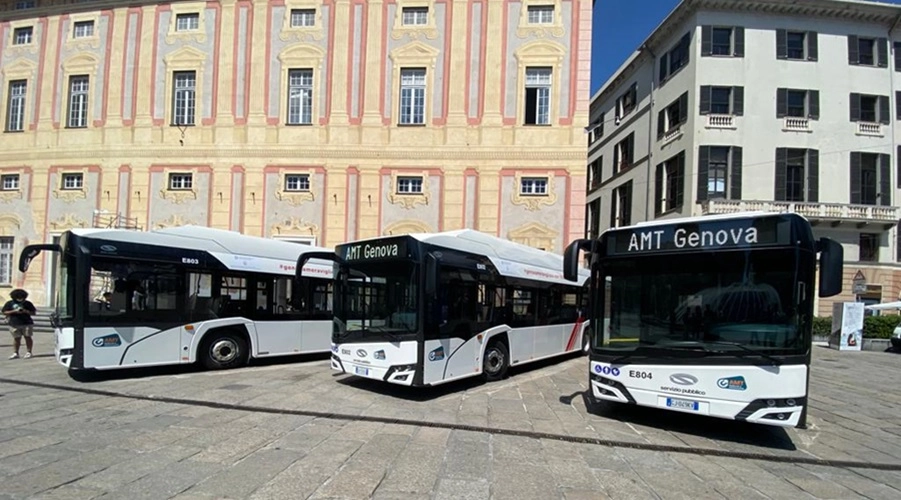Genoa, the capital of the Liguria province and one of Italy’s major cities, carried out in 2023 and thus far in 2024, a series of projects to promote sustainable mobility.
Among the standout projects concerning public transportation are the announcement of the installation of the country’s first ultra-fast charging system, the adoption of electric buses, the Skymetro project and the opening of six modern stations for micromobility vehicles.
Below, Mobility Portal Europe provides details on each of these initiatives.
New units to boost the public fleets
On January 3, the entry of 130 new vehicles, trolleybuses, and buses into the city’s transportation system was announced.

A significant portion of the units will be supplied by Solaris, in partnership with Skoda.
Both companies, will deliver 112 IMC trolleybuses valued at more than 100 million euros.
Within the new contract, the company Hess is also included, providing electric buses with fast charging for the Valbisagno route.
The buses will be delivered by October of the coming year for an amount of 31 million euros.
An innovative ultra-fast charging system
The city of Genoa will be the first in the entire country to have an ultra-fast charging system to supply its public transport units. It allows recharging buses in just five minutes.
The name of this energy technology is Grid e-Motion, and its producer is Hitachi Energy, a Switzerland-based company.
One of the innovative advantages that this machinery proposes is the possibility for the vehicle to replenish its power during stops in its route, due to the short time allowed by this charger.
This is done using an intelligent pantograph on the roof, which connects autonomously and automatically to the feeding stations and the batteries on the roof.
This increases the effectiveness and speed of public transportation services.
The technology will apply to 34 electric buses in the capital of Liguria, specifically those buses on the Val Bisagno line.
The system will be operational before the end of 2025.
This upgrade to the infrastructure is part of the 4 Axes of Strength project for local public transport in the city.
The agreement was reached between the City of Genoa and a temporary grouping of companies. Specifically, three firms will work together: Colas Rail, ICM, and Leonardo.
The contract includes executive design and the supply of civil works, systems, and technological infrastructure and foresees the creation of a trolleybus system and buses with zero pollutant emissions.
“Efficiency, accessibility, and sustainability” are at the center of this document, according to the official page of the Municipality of Genoa.
This project will be covered with part of the 471 million euros that the national government allocated to the city.
The purpose of this financial contribution is the renewal of the vehicle fleet, infrastructure works, and the renewal of warehouses equipped for electric recharging, with the aim of modernizing its transportation system.
This budget is a component of the National Recovery and Resilience Plan (PNRR), a program presented by the EU to provide extensive financial support in response to the challenges that the pandemic has posed to the European economy.
Micromobility stations
On Wednesday, December 27th, the Municipality of Genoa inaugurated a micromobility initiative.
This involves the opening of six modern stations for secure, covered, and free parking.
The new structures are located at the Brignole, Pra’, Cornigliano, Bolzaneto train stations, and in the city center at Piazza Dante and Darsena on Via Gramsci.
This service is designed to facilitate bike-train intermodality.
Additionally, the structures, made of steel and glass, are illuminated and video-monitored.
Social discussions about public transport works in Genoa
Recently, new details were revealed about the Skymetro project, a new bus metro infrastructure that will be installed in the capital of Liguria above ground level.
It is an elevated infrastructure, outdoors, without traffic interference, constituting an extension of the existing metropolitan network.
The plan was presented by the Mobility Councilor of the Municipality of Genoa, Matteo Campora, and by the Coordinator of Sustainable Urban Mobility, Enrico Musso.
“It is an innovative and sustainable project, with seven kilometers of photovoltaic panels that will power the metro: it will improve the quality of life of citizens with a connection in less than 11 minutes,” explained Campora.
The works are expected to be completed by the year 2027.
However, this implementation did not have unanimous approval from society.
Last year, when the project was still in the planning stages, Mayor Marco Bucci received criticism from local environmental groups.
Activists argued that the construction of such infrastructure would compromise the landscape of the locality.
Furthermore, they advocated for the tram option that was also under consideration at that time.
Regarding this, Bucci stated, “The excavations would be up to 80 centimeters, and this implies redoing the underground services, blocking the roads for three years of work.”
“I also wanted the tram, but it was not the right solution,” he said.







